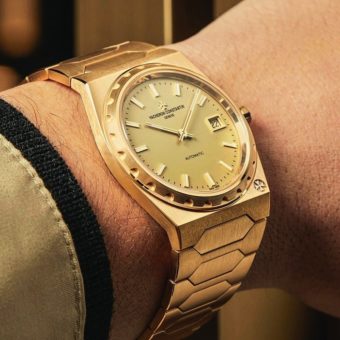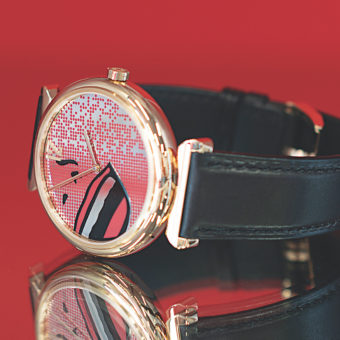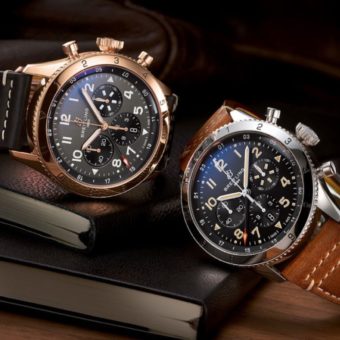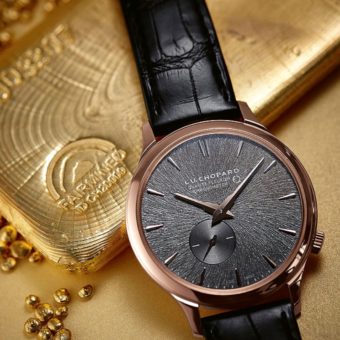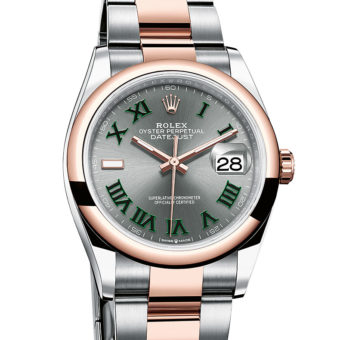
At SIHH, Girard-Perregaux’s Haute Horlogerie collection will be enhanced by the addition of a model inspired by its history and its complication: the Girard-Perregaux 1966 Tourbillon with Gold Bridge. Expressing the essence of Girard-Perregaux watchmaking tradition, it will be available in an edition of 50 individually-numbered pieces.
In the mid-19th century, Constant Girard-Perregaux created a timepiece that was awarded a first-class prize by the Neuchatel Observatory. Its tourbillon movement featured three parallel bridges, under which the barrel, center wheel and tourbillon were aligned. In this innovative concept, the tourbillon served not only as a technical and funcational component, but as a design element as well. In 1889, the watchmaker received the ultimate accolade: Girard-Perregaux won a gold medal at the Paris Universal Exhibition for his Tourbillon with Three Gold Bridges.
The new 1966 Tourbillon With Gold Bridge evokes its illustrious predecessors and pays tribute to tourbillon pocket watches. The “Breguet” Arabic numerals painted on the silvered dial, as well as the blued steel leaf-shaped hands, are both clear references to a time when only pocket watches existed. The clean lines of its 40-millimeter case disguise a sophisticated design and production process. Its curvature and lugs have been carefully fashioned to sit perfectly on the wrist. The case-back, closed by 6 screws, is hand-engraved to evoke the domes of Girard-Perregaux’s tourbillons dating from the 19th century. Each piece bears its own individual number, also engraved by hand in keeping with the Brand’s tradition.
The case houses a Girard-Perregaux 9610 movement comprising 224 components, the refined decoration and architecture of which are also inspired by 19th century pocket tourbillons.
The tourbillon bridge of the new Girard-Perregaux 1966 Tourbillon has an unusual shape: known as “bassiné”, the two arms of the bridge are rounded off. The rounding off process consists of filing the ends of the arms to make them perfectly uniform, giving them a semi-cylindrical shape while retaining the demarcation of the center and the heels. To finish the operation, the craftsmen use stones, buffs, boxwood and diamond pastes to smooth them to a perfectly rounded finish. The slightest imperfection can be immediately detected by the naked eye. This craftsmanship requires the highest level of dexterity and concentration.
The delicate tourbillon also demands extreme attention to detail: incredible dexterity is required to assemble its 72 components, all of which fit into a diameter of just one centimeter. It weighs 0.3 gram – about the same as a swan’s feather. Accompanying it is a self-winding system patented by the Manufacture: a small-diameter platinum oscillating weight is housed in the space below and around the barrel. This elegant design leaves the movement’s dimensions and architecture intact.
Technical specifications appear below the images.




Technical Specifications
Girard-Perregaux 1966 Tourbillon with gold Bridge (ref. 99535)
Pink gold case
Diameter: 40.00 mm
Antireflective sapphire crystal
Case-back fastened with 6 screws
Water resistance: 30 metres (3 ATM)
Girard-Perregaux 9610 Mechanical self-winding movement
Calibre: 28.60 mm
Frequency: 21,600 vibrations/hour (3 Hz)
Jewels: 31
Power reserve: minimum 48 hours
Functions: Tourbillon, hours, minutes, small seconds on the Tourbillon
Alligator strap with pin buckle
Limited and numbered edition of 50 pieces
Girard-Perregaux Movement 9610
Movement dimensions: Diameter: 28.60 mm
Height: 6.88 mm
Number of components Complete movement: 224 components
Tourbillon cage: 72 components, 0.3 g
Jewelling: 31 jewels
Power reserve: Minimum 48 hours
Barrel Circular-grained cover
Self-winding: Micro-rotor mounted on barrel staff crafted in platinum, patented by Girard-Perregaux
Balance: Free-sprung with gold adjustment screws (diameter 8.35 mm), lift angle 52°
Frequency: 21,600 vibrations/hour (3 Hz)
Balance spring: Philips terminal coil – Breguet hairspring
Main plate: Rhodium-plated, circular-grained, polished corners, circular-grained and bevelled recesses
Tourbillon bridge: Gold “bassiné” bridge, hand-polished (inspection under 10x magnifier), polished corners, satin-finished rims
Gear trains Involute gear profile
Tourbillon
One rotation per minute
Upper and lower cages bevelled and polished
Cage balanced with gold adjustment screws
Escapement bridges and pallet bridge bevelled and polished
Screws: Beveled and black-polished
Steel parts: Drawn out and beveled
Display: Hours and minutes
Small seconds on the Tourbillon
Exterior
Case materials and finishes: Pink gold with anti-reflective sapphire crystal
Case-back closed by 6 screws, hand-engraved
Hand-engraved individual number
Case dimensions: Diameter: 40 mm
Height: 10.90 mm
Case water resistance: 30 meters
Crown: Gold with engraved GP logo
Hands: Hour and minute, in blued steel
Strap: Full grain black alligator
Buckle: Pin, gold, with engraved GP logo


